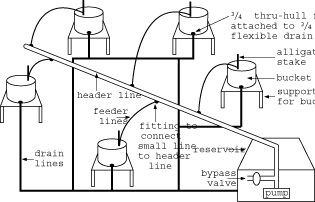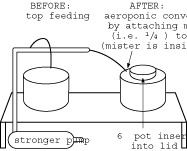The bucket system is a productive way to grow large plants and recirculate the solution. Plants like peppers and tomatoes are two such kinds of plants that can thrive in systems like this.
Building a Top Feeding Bucket System
Option B: Bucket System
Tools
1. Drill and 1-inch hole saw.
2. Knife.
3. Wrench.
Materials
1. One 3 to 4-gallon mesh pot or one solid 3 to 4-gallon bucket per plant.
2. One 5-gallon bucket per plant.
3. One to two 3/4-inch thru-hull fittings per plant (one for mesh pot, two for solid buckets).
4. One 3/4-inch T per plant.
5. 3/4-inch yellow flex hose (enough to connect plants together and to connect to reservoir).
6. One reservoir with 3/4-inch thru-hull fitting in the bottom.
7. One 3/4-inch T.
8. One roll of 1/2-inch black poly tubing.
9. One roll of 1/8 or 3/16-inch black poly tubing.
10. One fitting per plant to connect 1/2-inch tubing to 1/8 or 3/16-inch tubing.
11. One alligator stake per plant.
12. One 1/2-inch T fitting.
13. One 1/2-inch end cap.
14. One to two 1/2-inch elbows.
15. One 1/2-inch female threaded fitting for pump.
16. One pump.
Support System: Building the system
With a bucket system, a mesh pot or bucket (with plant and growing medium) is stacked into a 5 to 7-gallon pail.
A. If a bucket is used, a 3/4-inch thru-hull fitting should be inserted into the bottom so that solution can drain into the bottom pail.

B. The bottom pail should have a 3/4-inch thru-hull fitting in the side near the bottom. If this hole is too low, the thru-hull fitting won’t fit.
C. A short piece (approximately 6 inches) of 3/4-inch yellow hose should be attached to the 3/4-inch thru-hull fitting.
D. A 3/4-inch T should be inserted into the other end of the hose.
E. The open ends of the T should be connected to other buckets with yellow flex tubing.
F. After all buckets are connected, there should be two open ends from the 3/4-inch T fittings attached to two of the buckets. The final stage is to attach these fittings to hose, then to attach both ends of hose to another 3/4-inch T. Then the hose is connected to the 3/4-inch thru-hull fitting on the bottom of the reservoir. The reservoir should be located lower than the pails so the pails drain well.
G. A piece of 1/2-inch poly tubing (feeder line) is cut and laid near the plants.
H. A 1/2-inch end cap is inserted at the end away from the reservoir. Soaking tubing in hot water allows for easier connections.
I. A 1/2-inch poly elbow is inserted at the open end that is nearest the reservoir. The elbow should be directly above the reservoir.
J. 1/2-inch black poly tubing should be connected to the other end of the elbow and then to the pump. A highly recommended option is to put a bypass valve or a 1/2-inch T just after the pump so that the solution stays aerated and agitated, and the flow can be controlled. More 1/2-inch fittings can be placed on the bypass valve so that the aerated liquid is forced to the bottom near the pump. Also, forcing water downward can reduce possibilities of splashing and making a mess on the floor.
K. Small holes should be poked into the 1/2-inch poly header line that is on the flood table. A punch or small drill bit can be used to make the holes for the fittings.
L. 1/8 or 3/16-inch tubing is connected to the fittings and secured to each pot using alligator stakes. It is best to look ahead to see where the plants will be when it is harvest time so that the proper lengths can be cut.
Feeding
It is easiest to feed the plants with the pump timer running full-time only during the light hours. A solar pump would allow for this. But plants can be fed continuously (all day and all night). Also, plants can be fed intermittently (i.e. every 20 minutes for 2 minutes) during the light hours, or for all hours.
Hydroponic to Aeroponic Conversion
Many top-feeding hydroponic systems can be converted to aeroponic systems by using a stronger pump, adding a mister for each plant, and changing the position of the mister to feed roots in the air (under the lid) as opposed to top feeding. Hydroponic systems that use less growing medium will work best, such as those grown in PVC or gutter pipe.
In this case, a small, say, 6-inch mesh pot will be used to replace the old 3-gallon bucket. The mesh pot with a small amount of growing medium should then be placed in a lid. Then the mesh pot gets inserted into a 5 to 7-gallon pail. Adding a mister for each bucket (to feed inside the pail) and a high-powered pump completes the conversion. A small hole must be made in the 5 to 7-gallon pail to accommodate the tubing and mister. 1/8 to 1/4-inch tubing and matching misters are good sizes to use with the conversion.



